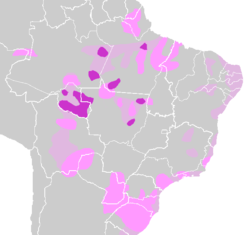Amazonian languages
The term Amazonian Languages refers to the indigenous American languages of the Amazon basin . They are a heterogeneous group of languages that belong to different families , but which do not have common roots. Nevertheless, they combine some typological features due to the continuous contact between them, as well as with other languages of South America .
The linguistic diversity of the Amazonian languages is remarkable in every way. As a result, some authors propose to speak of the Amazonian language federation . Nevertheless, due to the spread of national languages, especially Spanish and Portuguese, this diversity is gradually dying out and the indigenous languages of South America are more or less dying.
overview
From a cultural perspective, the Amazon rainforest is one of the most diverse linguistic regions in the world. About 350 languages are spoken in the Amazon Basin, grouped into about 20 different families plus a fairly large number of isolated languages . A clear phylogenetic relationship has not yet been proven, although cultural and linguistic diversity go back thousands of years. This diversity was likely to be preserved because the Amazon region never had domains that could last long enough to effectively influence culture and language.
The large language families in this region are:
- Tupí languages : today the most widespread family of indigenous languages in this geographical area - although some of the expansion happened only recently.
- Macro-Ge languages : it comprises 41 languages, 23 of which are already extinct, and is found mainly in the eastern part of the Amazon lowlands.
- Caribbean languages : these 29 living languages are particularly widespread in the northern part of South America, from the mouth of the Amazon to the Colombian Andes.
- Arawak languages : the second largest language family literally circles the Amazon.
- Pano-languages : 28 languages of this family are spoken on both sides of the Brazilian-Peruvian border.
- Tacan languages : this family is common in the southwest of the Amazon.
- Tucano languages : with around 25 individual languages, this language family occurs in the north-west of the Amazon.

The Tupí language family is the most common language family in the Amazon Basin.
|

Distribution of the Macro-Ge language family .
|

Current places where the Caribbean languages are still spoken.
|

The Arawak languages of South America form the second largest language family in the Amazon.
|

Present-day occurrence of the Tucano languages .
|
In addition to these unrelated, linguistic groups, there are a number of important, small language families that have not yet been categorized. They are therefore viewed as an independent group. Multilingualism was (and is) the norm of the Amazon Indians.
Individual evidence
- ↑ a b c d e Alexandra Y. Aikhenvald : The Languages of the Amazon. Oxford University Press, Oxford et al. 2012, ISBN 978-0-19-959356-9 , p. 1.
- ^ Robert MW Dixon , Alexandra Y. Aikhenvald (Eds.): The Amazonian Languages. Cambridge University Press, Cambridge et al. 1999, ISBN 0-521-57021-2 , p. 8.
- ^ Robert MW Dixon, Alexandra Y. Aikhenvald (Eds.): The Amazonian Languages. Cambridge University Press, Cambridge et al. 1999, ISBN 0-521-57021-2 , p. 2.
